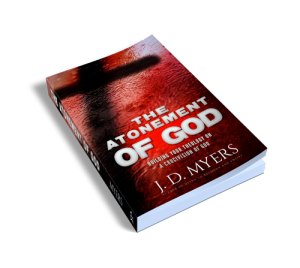My new book, The Atonement of God, has the subtitle “Building Your Theology on a Crucivision of God.”
A few people have emailed me or messaged me on Facebook to ask if this is a typo. It is not.
I coined the word to describe what I am trying to do in the book. I want you to gain a vision of God which is based on the crucifixion of Jesus. I put the words “vision” and “crucifixion” and together and out came “crucivision.”
I did this because I wanted to present a cross-shaped, or cruciform, presentation of God.
There are two common approaches to understanding God from Scripture.
The Chronological Approach to God
Some take the chronological approach, so that they begin with Genesis 1:1 and work their way through Scripture trying to piece all the ideas about God into one coherent picture.
 But since the way God behaves in the Old Testament looks much different from the way God behaves in the revelation of Jesus Christ, the chronological approach to learning about God leaves us with what Greg Boyd calls a “Janus faced God.” Janus was the two-faced God of Roman mythology where one side was kind and loving and the other side was mean and angry.
But since the way God behaves in the Old Testament looks much different from the way God behaves in the revelation of Jesus Christ, the chronological approach to learning about God leaves us with what Greg Boyd calls a “Janus faced God.” Janus was the two-faced God of Roman mythology where one side was kind and loving and the other side was mean and angry.
Just as the Romans never knew which face of Janus was going to show up at any one time, this is how many people feel about God when they adopt a chronological approach to the revelation of God in Scripture.
It is a “He loves me; He loves me not” approach to God. We can never be sure exactly where we stand with God, or whether He currently hates us and wants to incinerate us or loves us and wants to be with us.
I would say that most of Western Evangelical Christianity currently falls into this sort of view of God.
The Christological Approach to God
Since many people see that the God revealed in Jesus is often different than the God revealed in the Hebrew Scriptures, some people say that the revelation of God in Jesus Christ trumps the revelation of God in the Old Testament, and wherever the two disagree, the revelation of God in the Old Testament is wrong.
This view is better than the Chronological approach, but suffers from a different set of problems.
The main problem with this view is that those who hold a Christological approach sometimes simply write off much of the Old Testament revelation of God as being hopelessly in error. Since Jesus is the main revelation of God in this view (which I agree with), they sometimes then go on to say that anything in the Old Testament which doesn’t look like Jesus is therefore an error. It seems that ultimately, what this does is set humans up as judge over Scripture to determine what is “true” and what is “error.”
I am not comfortable with this approach to Scripture at all. While I do believe that Jesus is the ultimate and most perfect revelation of God, I also believe all Scripture is inspired and inerrant. So out of my conviction of Scripture as being inspired and inerrant, and out of my desire to read Scripture through a Christological lens, I developed my Crucivision theology.
The Crucivision Approach to God
The crucivision approach to Scripture allows the revelation of Jesus to be the guide and lens by which we interpret the rest of the revelation about God in Scripture.
A crucivision approach to Scripture allows Jesus, and specifically the crucifixion of Jesus, to show us what God is really like.
Some have called this the Christotelic lens or the Cruciform reading of Scripture, but I prefer Crucivision because it shows us that it is not just Jesus Christ who provides us a way of reading the Old Testament texts about God, but is specifically Jesus Christ on the cross that helps us see God in a whole new light.
 Once we see that God is most fully revealed in Jesus Christ, and especially in Jesus Christ dying on the cross, this then begins to cause great changes in how we read and understand the rest of the Old Testament. We see that what God was doing in Jesus Christ on the cross is exactly what God has always been doing in Himself on the pages of the Hebrew Scriptures.
Once we see that God is most fully revealed in Jesus Christ, and especially in Jesus Christ dying on the cross, this then begins to cause great changes in how we read and understand the rest of the Old Testament. We see that what God was doing in Jesus Christ on the cross is exactly what God has always been doing in Himself on the pages of the Hebrew Scriptures.
Jesus is not then in discontinuity with the revelation of God in the Old Testament, but is rather the most clearest example of how to read about God in the Old Testament.
Gaining a Crucivision of God helps us understand not only God, but also ourselves, sin, forgiveness, justice, and a whole host of other theological topics. I cover 10 of these in my book.
To learn more about this way of reading Scripture and gain a Crucivision theology, buy my book on Amazon today.
How do you understand the violent portions of Scripture? Is this really how God is? Did Jesus hide this aspect of God from us during His three years of earthly ministry? Or maybe you have a way of reading the Bible through the lens of Jesus Christ which maintains that God is always loving, always forgiving, and always kind? Add your thoughts in the comment section below.




I read your post (but not the book, yet) on the non-violent atonement, and I am unsure how to understand verses such as “Without the shedding of blood there is no remission” in the light of your “non-violent” concept; it’s unclear to me.
Well, you’re in luck! There is an entire Appendix in this book on that very verse.
How is the OT or what do you mean by “much of the Old Testament revelation of God is hopelessly in error”? Thanks!
Jeremy, I’m patiently waiting to see your reply to Nelson’s question above.
Putting your quote into the context of your belief in ALL Scripture being inspired and inerrant gives the impression of the two thoughts being oxymoronic.
But, I’ve been reading you long enough to know your probably intentionally setting up an antinomy (equal but opposing truths)!
Blessings & shalom in Yahshuah, Gary
Hi Nelson (and Gary),
I don’t believe the OT is in error, so was confused by your question, and went back to see what I had written. My statement was unclear. I was describing the way some scholars and theologians view the OT who have a “Christological” approach to Scripture. Because of their “Christological” lens, some of these scholars simply say that anything that doesn’t look like Jesus is an error.
I don’t hold to that position at all. I will try to clarify the article above.
Thanks for clarifying…